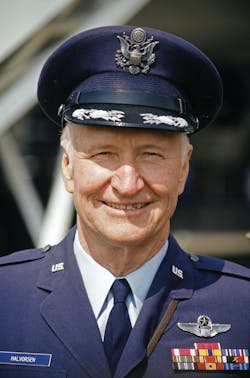How The Halvorsen Loader Got Its Name
Readers will find a history of ground support equipment starting on page 8 to coincide with our own part of that history – this issue marks 20 years in business publishing the leading voice of the ground support community.
Of course, there are “GSP,” too – “ground support people” behind the tractors and the loaders and the refuelers and the baggage carts and the deicers.
For example, you’ve no doubt heard of Hobart Brothers, the company. But what about Edward, Charles and William Hobart, the brothers? JLG Industries is currently a part of an $8 billion corporation. But back in 1969 it was just John L. Grove and a couple of his buddies who bought a metal fabrication shop. Did you know that in 1951 a guy named Fred joined a company started by a guy named Davis to sell electric vehicles to ranchers and nurseries throughout Southern California? You definitely know both their last names. And if you’re stumped, turn to page 10, third column, almost at the bottom.
No doubt the most unlikely GSP in our list is John Bean. The “JB” in JBT Aerotech, Bean invented a better sprayer to eradicate insects from his own 10-acre almond grove in the 1880s. The sprayer turned out to be just what other orchard owners needed and his company grew from there. Then, about 70 years, his sprayer innovation turned out to be just what the first generation of aircraft deicers needed.
A GSP doesn’t necessarily have to be a manufacturer either. For example, we talked with Bob Kuzma, Abbott Installs, New York, who was a structural iron worker for Pacific Iron & Steel, who installed the first passenger boarding bridges at LaGuardia Airport in 1959.
“People just used to walk out onto the tarmac in all kinds of weather to board a plane,” Kuzma says. But as soon as one airline put in a boarding bridge, it was only a matter of time before they all did.
“All you needed was for one president of an airline to walk outside in the rain only to see that his competitor had a boarding bridge for its customers,” he adds.
We had heard that Kuzma put in the very first passenger bridge in the United States, and there’s no doubt he put in the first one at LGA. But the very first? Clear across the country, San Francisco Airport lays claim to the country’s first passenger bridge also installed in 1959.
“Yeah, they may have been putting them in there, too,” Kuzma adds. But whatever the exact date, it didn’t really matter to Kuzma since he went into the business himself installing the bridges and air cargo systems along the East Coast during the 1960s.
“I had no competition,” he laughs. “No one knew about this equipment at the time.” Still, to be on the safe side, he named his company “Abbott” because “A” comes before “K” in the Yellow Pages.
As it turns out, there’s at least one GSP who isn’t even from the GSE industry. We found out the back story to a man on the peripheral of a product even though it bears his own last name.
Col. Gail Halvorsen, a retired career officer in the U.S. Air Force, was known as the original “Candy Bomber” during the Berlin airlift, which provided 4,700 tons of food and supplies to the city between 1948-1949.
Shortly before he landed at the Tempelhof Airport, Halvorsen would drop candy attached to the parachutes to children living near the site. Since children couldn’t tell one plane from another, Halvorsen would wiggle the wings of his plane. That led to his nickname, “Onkel Wackelflugel” or Uncle Wiggly Wings.
His action inspired other pilots to do the same. Eventually the candy drops were made official. After press back in America led to public donations, Halvorsen was able to drop 850 pounds of candy. By the end of the airlift, the military figured pilots had dropped 23 tons of candy.
Halvorsen went on to become the commander of the Tempelhof Air Base, and cement relations with post-war Germany.
In honor of the man, the U.S. Air Force named its next generation loaders. The first Halvorsen loaders were delivered in 2000.
We’ll continue to remember the equipment and people that make the industry throughout the rest of 2013.









